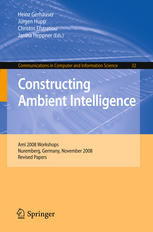

Most ebook files are in PDF format, so you can easily read them using various software such as Foxit Reader or directly on the Google Chrome browser.
Some ebook files are released by publishers in other formats such as .awz, .mobi, .epub, .fb2, etc. You may need to install specific software to read these formats on mobile/PC, such as Calibre.
Please read the tutorial at this link: https://ebookbell.com/faq
We offer FREE conversion to the popular formats you request; however, this may take some time. Therefore, right after payment, please email us, and we will try to provide the service as quickly as possible.
For some exceptional file formats or broken links (if any), please refrain from opening any disputes. Instead, email us first, and we will try to assist within a maximum of 6 hours.
EbookBell Team

0.0
0 reviewsAmbient intelligence (AmI) was established in the late 1990s as a recent paradigm for electronic environments for the timeframe of 2010–2020. AmI is essentially an elabo- tion of Mark Weiser’s vision of ubiquitous computing. Weiser was aiming at a novel mobile computing infrastructure integrated into the networked environment of people. AmI is the idea of a technology that will become invisibly embedded in our natural s- roundings, present whenever we need it, enabled by simple and effortless interaction, attuned to all our senses, adaptive to users, context-sensitive, and autonomous. AmI refers to smart electronic environments that are sensitive and responsive to the presence of people. Since its adoption the vision has grown and fully developed, bec- ing quite influential in the development of novel ideas for information processing and new concepts for multi-disciplinary fields including electrical engineering, computer science, industrial design, user interfaces, and cognitive sciences. The AmI system - fords a basis for new paradigms of technological innovation within a multi-dimensional society. The added value of the AmI vision is the fact that the large-scale integration of electronics into the environment allows the actors, i. e. , people and objects, to collaborate with their surroundings in a natural measure. This is directly related to the increasing societal demand for communication and the exchange of information.